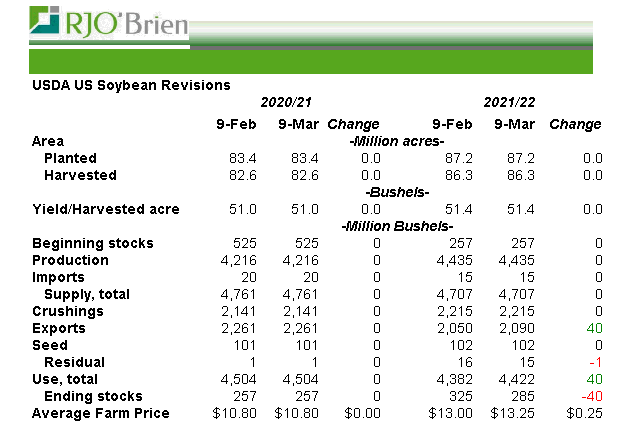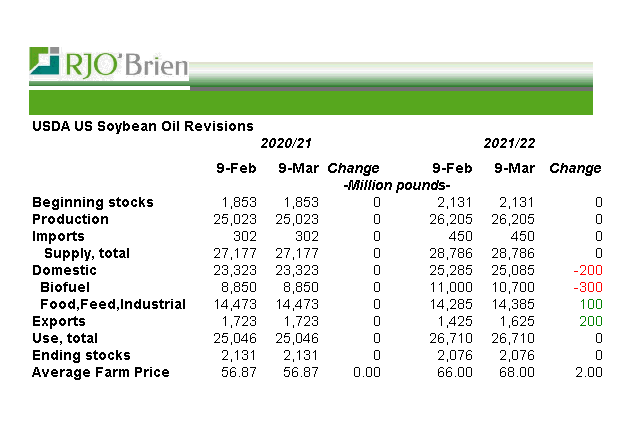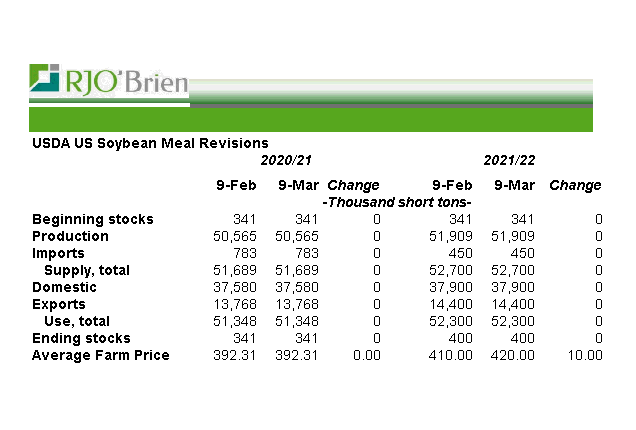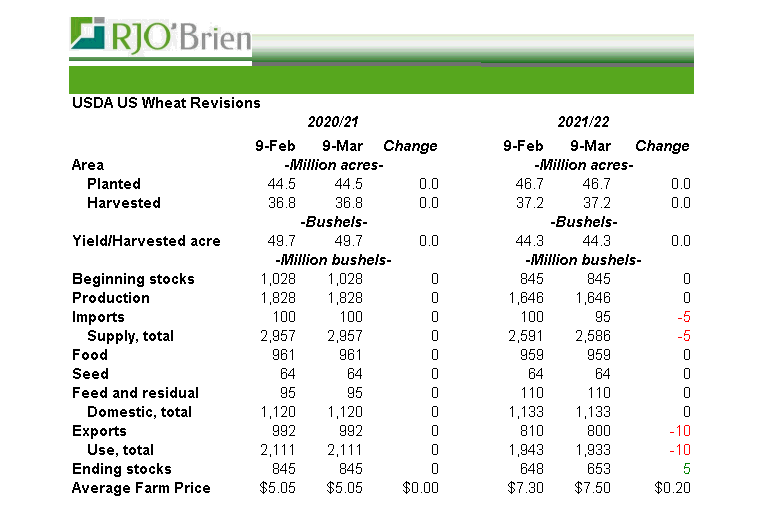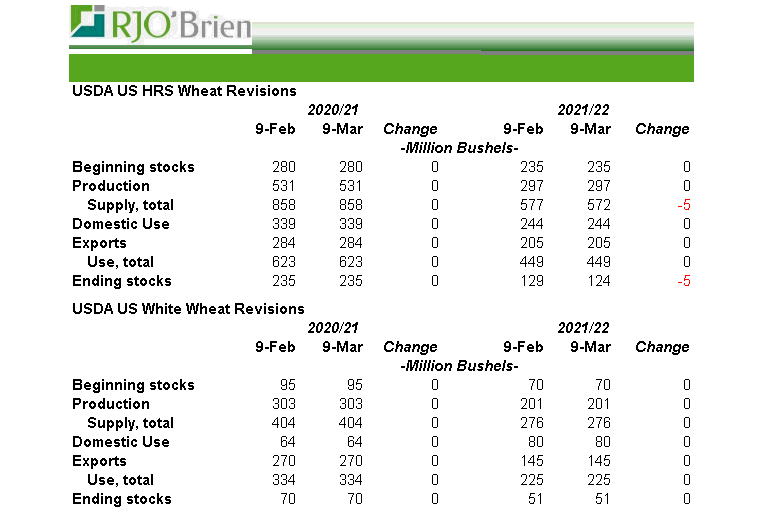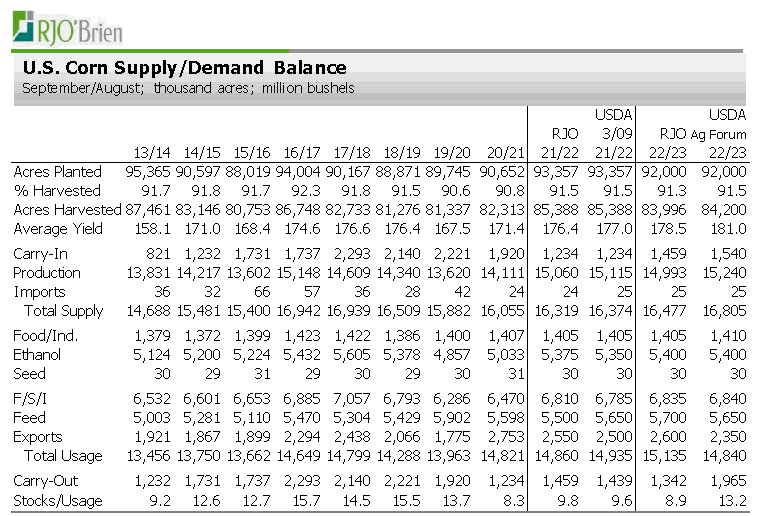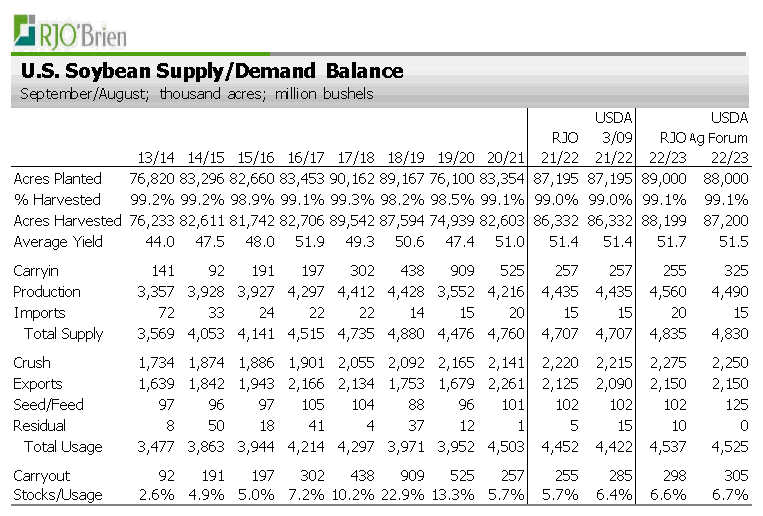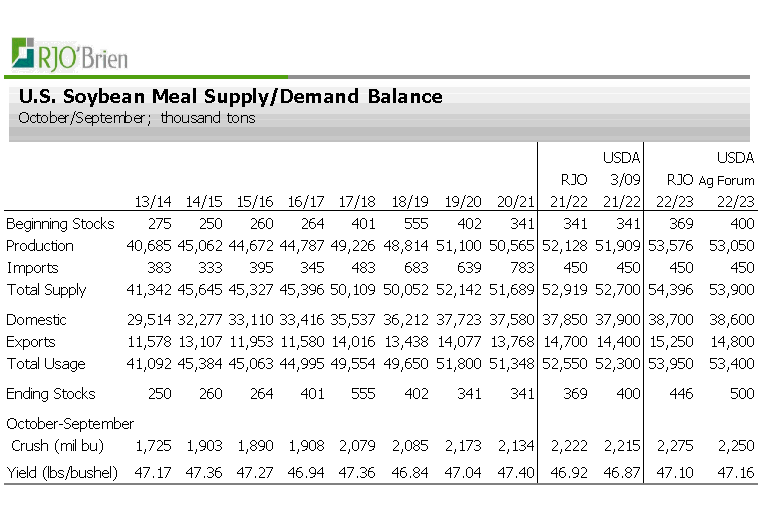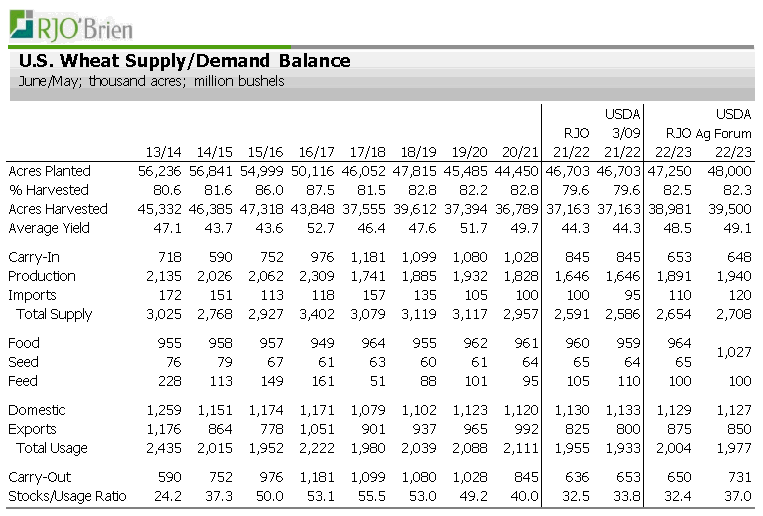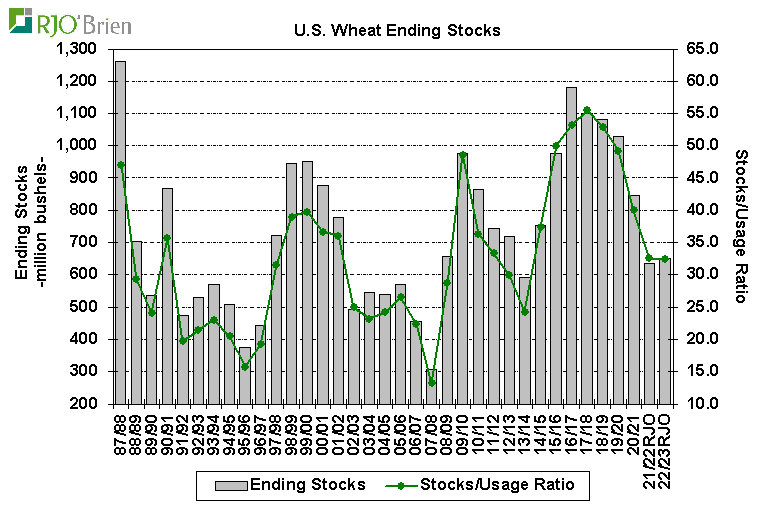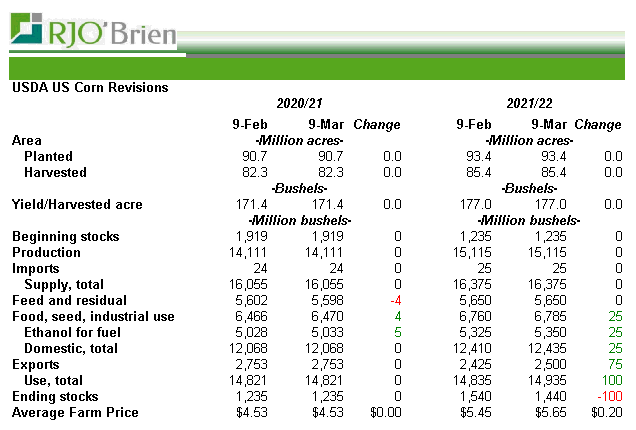While there were no major surprises in today’s USDA WASDE report for corn, wheat, soybeans or soybean products, they began the process of attempting to adjust global supply/demand structures in light of the Russian war on Ukraine, notably lowering corn and wheat exports from the region, while shifting demand to other suppliers as warranted. Accordingly, USDA lowered U.S. corn and soybean ending stocks largely in line with expectations, but the U.S. wheat balance sheet continues to be the weak link in the global arena as exports were actually lowered slightly, prompting an unexpected small uptick in ending stocks.
A summary of key report numbers relative to market expectations is attached to this post as a PDF file.
Corn
USDA’s U.S. corn balance sheet revisions were largely in line with overall expectations, reflecting higher corn for ethanol usage and exports, as needed for both, based on recent demand factors/observations. While there clearly are no certain answers with how things will transpire given recent events with Russia and Ukraine, USDA made an initial attempt today to begin the process of assessing reduced export availabilities out of the region and potential trade pattern flows to come.
USDA raised U.S. corn exports by 75 million bushels (1.9 MMT) from last month to 2.500 billion, but still down 253 million bushels (9.2%) from last year’s 2.753 billion. Based on their new export projection, we estimate corn export sales will now need to average roughly 21.3 million bushels/week through the end of August vs last year’s 16.5 million from this point forward last year. When looking at the progress of the 2021/22 U.S. corn export program, there has been lots of discussion of the considerable difference between official Census Bureau trade data and the well-followed Export Inspections data. Just-released January Census data continued the situation seen all year so far, with monthly Census exports running, on average, roughly 30 million bushels higher than those reported by Inspections data, with marketing year-to-date (Sept-Jan) Census exports essentially unchanged from last year, while cumulative Export Inspections are running nearly 140 million bushels less than Census. Trade regulations with how U.S. grain exports to Canada are handled for reporting purposes is the main reason for the significant difference. On the other hand, though, the same is not the case looking at Export Sales data and the marketing year-to-date difference is only around 55 million bushels so far and continues to be a much better focal point when tracking the progression of this year’s export program.
The upward revision in U.S. corn exports was clearly needed based on recent sales/export activity, but very well could/should still move higher yet as the Russian/Ukraine situation plays out. USDA lowered Ukrainian corn exports today by 6 MMT from last month to 33.5 MMT, but still remain above last year’s 23.9 MMT. Based on estimated Oct-Feb marketing year to date Ukrainian exports, we estimate their March-Sept exports would need to be 9.2 MMT based on the USDA’s new annual estimate vs 10.6 MMT exported during the same period last year. Clearly a good portion of that 9+ MMT export potential is questionable at this time, even as Ukraine attempts to continue exporting some quantity of corn via rail through its western border countries. USDA also lowered the Argentine corn crop by 1.0 MMT to 53.0 MMT (51.6 MMT average trade estimate/51.5 MMT last year), but left their exports unchanged at 39.0 MMT vs 40.6 MMT last year. We fully expect the Argentine crop to eventually be lowered by another 2-3 MMT in future WASDE reports, likely prompting a modest reduction in exports at the time. USDA left the Brazilian corn crop unchanged at 114.0 MMT (87.0 MMT last year) and exports at 43.0 MMT (21.0 MMT last year) which is appropriate for now given the favorable start to the safrinha crop growing season. Keep in mind, though, the potentially significantly higher Brazilian exports this year will impact the global picture July forward, having little impact on the 2nd half U.S. export program, but potentially/likely impacting early 2022/23 U.S. exports. USDA left the Chinese corn situation unchanged this month with imports at 26.0 MMT (29.5 MMT last year) and stocks at 210 MMT (206 MMT last year). We’re estimating U.S. corn exports now at 2.550 billion bushels and still leaning higher but needing to see continued confirmation of active sales activity moving forward.
USDA raised U.S. corn for ethanol usage this month by 25 million bushels to 5.350 billion (5.033 billion last year) in a warranted increase given the impressively steady nature of ethanol production of late despite the weak margin structure. Based on the new projection, we estimate U.S. ethanol production will need to run, on average, 2.8% above year ago levels through the end of August with production averaging roughly 1.028 million barrels/day, which was exactly what today’s weekly EIA data reflected for the week ended March 4. We’re still a bit higher in our balance sheet at 5.375 billion bushels, which will require a 3.7% average year-over-year increase in ethanol production from this point forward.
The net bottom line impact on the U.S. corn balance sheet was a 100 million bushel reduction in 2021/22 ending stocks this month to 1.440 billion bushels, essentially in line with average market expectations looking for a decline to 1.455 billion. With the lower stocks, USDA raised their projection of the 2021/22 average farm price by 20 cents/bushel to $5.65, reflecting a $1.12 increase from last year. The USDA’s balance sheet now works to a stocks/usage ratio of 9.6% vs 8.3% last year. Our ending stocks ideas are comparable to USDA as we’re at 1.459 billion bushels, but with higher ethanol and exports, lower feed/residual usage and our ongoing expectation for last year’s crop to ultimately prove a bit lower than reflected by USDA. However, we are leaning lower on stocks, with the quarterly Grain Stocks report due out on March 31 likely to be a major influence on balance sheet ideas moving forward as it will help clarify feed/residual usage, not only for the 2nd quarter, but also likely will hold notable implications for annual usage ideas, as well.
Soybeans
This month’s report was fairly quiet for soybeans as the Russian conflict is mostly a side influence fundamentally, while the reduced South American crop continues to positively impact U.S. export prospects. USDA made meaningful, but still not complete, downward revisions in their estimates of the South American crops, but also further lowered their expectations for this year’s Chinese soybean imports, as well.
The only revisions to the U.S. soybean balance were a 40 million bushel increase in exports to 2.090 billion (2.261 billion last year) and a 1 million bushel reduction in residual usage to 15 million. USDA left crush unchanged this month at 2.215 billion bushels, but appears to have upside potential with verification of expected solid year-over-year gains in crush through the end of the marketing year. While we can not fault USDA for holding the line on their crush estimate for now, as marketing year-to-date crush is still unchanged from last year vs USDA projecting a 74 million bushel increase from 2020/21, requiring Feb-Aug crush to run 6.5% above year ago levels, we feel there is upside potential in the USDA’s crush estimate if the biodiesel situation plays out as viewed as possible/expected. On that topic, though, USDA lowered their estimate of 21/22 soybean oil for biodiesel usage by 300 million pounds today, but more on that later.
Looking a bit closer at the export situation, the USDA’s new annual estimate of 2.090 billion bushels would require export sales to average roughly 9.3 million bushels/week through the end of August vs last year’s historically low 3.1 million/week average from this point forward and average sales during March-August over the prior 5-year period of 14.5 million/week. Honestly, it’s going to become increasingly difficult to add export bushels to the balance sheet moving forward, despite the South American crop situation, with ending stocks ideas declining considerably in recent months.
The USDA made solid downward revisions in their South American crop estimates this month, lowering Brazil by 7 MMT to 127 MMT (138.0 MMT last year), Argentina by 1.5 MMT to 43.5 MMT (46.2 last year), Paraguay by 1.0 MMT to 5.3 MMT (9.9 last year) and Uruguay by 0.6 MMT to 2.0 MMT (1.7 last year). Combined, South American production is now estimated down 19 MMT from last year and very likely to still move another 5-10 MMT lower yet. With the production reductions, USDA lowered Brazilian soybean exports by 5.7 MMT from last month to 78.8 MMT on a local marketing year basis (Feb-Jan) 85.5 MMT and down 9.7 MMT from last year’s 88.5 MMT. Argentine exports were lowered 1.0 MMT from last month and are now at a minimal 2.8 MMT on a local marketing year basis (Apr-Mar) vs last year’s 5.4 MMT. USDA left Argentine crush unchanged at 39.4 MMT (down 2.3 MMT from last year) and Brazil crush at 46.3 MMT, down 0.6 MMT from last month, vs 47.2 MMT from last year. Based on these changes, for now, USDA is estimating combined Brazil/Argentine soybean exports to be down 12.3 MMT from last year and crush down 3.2 MMT from last year, with more reductions very likely still to come. In at least a partial help to the situation, USDA further lowered their estimate of Chinese soybean imports this year by another 3 MMT to 94.0 MMT and down 5.8 MMT from last year’s 99.8 MMT. Based on Oct-Feb to date imports of 36.5 MMT, China would still have 57.5 MMT to import during Mar-Sep vs 53.7 MMT last year, with Brazil/Argentine total supplies currently estimated down 19 MMT from last year and moving lower. This is going to get very interesting very quick…
The bottom line saw USDA lower 2021/22 U.S. soybean ending stocks by 40 million bushels from last month to 285 million, essentially in line with market expectations as the average trade estimate was 273 million and compares to last year’s stocks of 257 million bushels. With our export and crush estimates still a bit higher at 2.125 billion and 2.220 billion bushels, respectively, we’re estimating ending stocks at 255 million, essentially unchanged from last year, with the stocks/usage ratio at 5.7%, the same as 20/21. Clearly room for additional U.S. soybean demand in this year’s balance sheet is becoming very limited as ending stocks ideas continue to decline.
For the products, in order to keep U.S. soybean oil ending stocks comfortable amid quickly rising export ideas, USDA lowered 2021/22 usage for biodiesel production by 300 million pounds from last month to 10.700 billion, but still up 1.85 billion pounds (12.2%) from last year’s 8.850 billion, with total domestic usage declining 200 million pounds this month to 25.085 billion (23.323 billion last year). This allowed USDA to raise soybean oil exports by 200 million pounds to 1.625 billion and down only modestly now from last year’s 1.723 billion and hold 2021/22 ending stocks unchanged at 2.076 billion pounds (2.131 billion last year). Even with the increased export projection, we estimate soybean oil export sales can still only average roughly 2.0k tonnes/week for the rest of the marketing year vs last year’s 3.0k/week average from this point forward. USDA left the soybean meal balance sheet completely unchanged this month, with the exception of the average farm price being raised $10/ton to $420 ($392.31 last year). They raised the average price received for soybean oil by 2 cents/pound this month to 68.0 (56.87 last year).
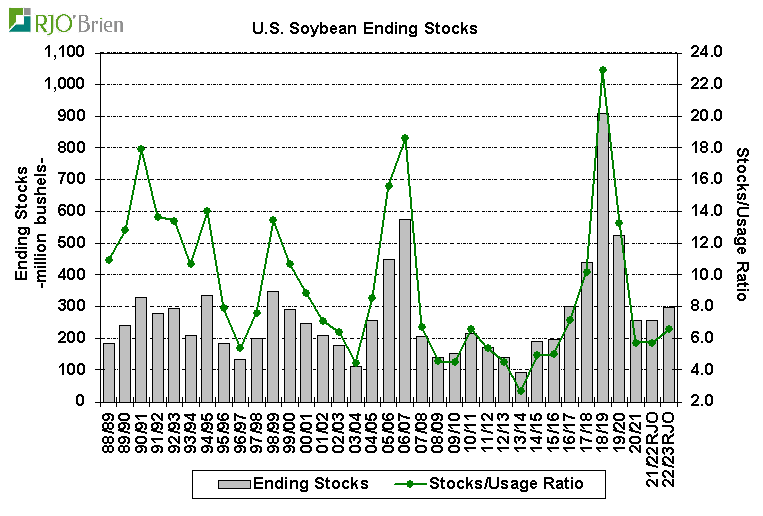
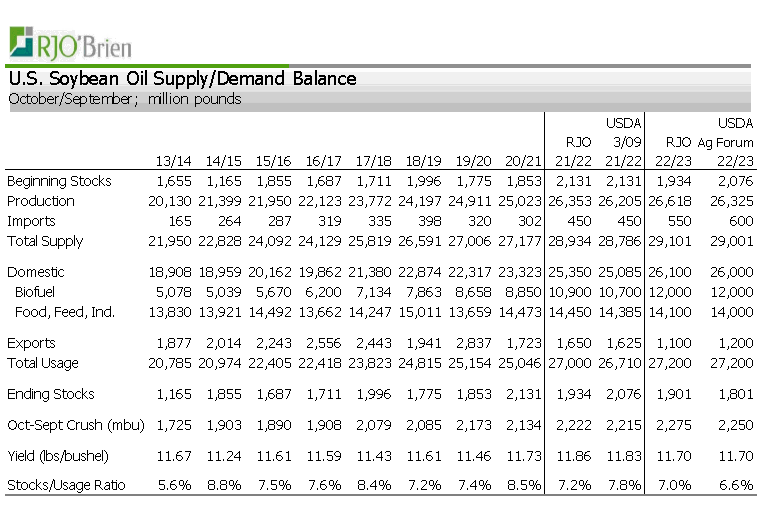
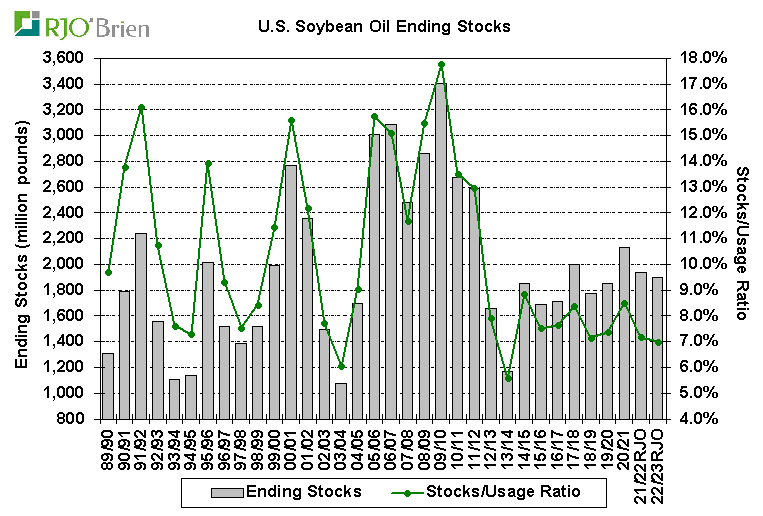
Wheat
Despite everything going on between Russia and Ukraine and the rampant massive concerns over the potential lack of available wheat supplies for global importers, the USDA still lowered 2021/22 U.S. wheat exports by 10 million bushels from last month to 800 million bushels, a 7-year low. While there have been occasional spurts of increased sales activity, the U.S. export program has remained quite tepid, prompting the USDA’s reduction this month with only three months remaining in the marketing year. With USDA lowering U.S. wheat imports by 5 million bushels, their 2021/22 U.S. wheat ending stocks estimate ticked up by 5 million bushels from last month to 653 million last month. With the new projection, we estimate wheat export sales will need to average roughly only 3 million bushels/week through the end of May vs last year’s 5.2 million/week average from this point forward. While there hasn’t been much change in the U.S. export picture with the Russian developments, we still feel there is the likelihood of a bit better demand in the last several months of the marketing year and have bumped our export estimate up to 825 million bushels. On that, we’re currently estimating U.S. wheat ending stocks at 636 million bushels vs USDA’s 653 million bushel estimate.
On the world front, while the U.S. balance sheet revisions were limited, USDA made widespread revisions as would be expected with the recent global developments. USDA lowered Russian wheat exports by 3.0 MMT and Ukrainian exports by 4.0 MMT last month to 32.0 and 20.0 MMT, respectively. Russian exports are now estimated to be down 7.1 MMT from last year, while Ukrainian exports would still be up 3.1 MMT. Based on the USDA’s new estimates and year-to-date exports through February, Ukraine would still have roughly 2 MMT of wheat to export during March-May vs 2.3 MMT last year, while Russia would have 5.5 MMT yet to export through May vs 4.6 MMT last year. With the reduced exports, USDA is estimating Ukrainian wheat ending stocks at 5.0 MMT, up from 2.0 MMT last month and 1.5 MMT last year, while Russian ending stocks are estimated at 13.1 MMT vs 10.6 MMT previously and 11.4 MMT last year.
Other global revisions saw USDA raise the Australian wheat crop to 36.3 MMT from 34.0 MMT previously (33.3 MMT last year), pushing exports up to 27.5 MMT from 25.5 MMT last month, but left the Argentine crop and exports unchanged at 20.5 MMT and 14.0 MMT, respectively (17.6/11.5 last year). USDA left Chinese wheat imports unchanged at 9.5 MMT (10.6 last year) as well as EU exports at 37.5 MMT (29.7 last year), while ticking Canadian exports up to 15.5 MMT from 15.2 MMT previously (26.4 MMT last year).
There continues to be an extreme amount of uncertainty with the global wheat situation as the Russian war carries on. The USDA reducing Black Sea exports by 7 MMT from last month while raising other major exporters’ exports by only 2.5 MMT is questionable to say the least. There are not going to be any easy answers to this situation as it plays out in the weeks and, likely, months ahead with extreme market volatility likely continuing for the foreseeable future as developments unfold. The bigger issue/concern for the global wheat situation may be in 2022/23 if Ukrainian wheat supplies are largely unavailable.
USDA Monthly Supply/Demand Balance Sheet Revisions
